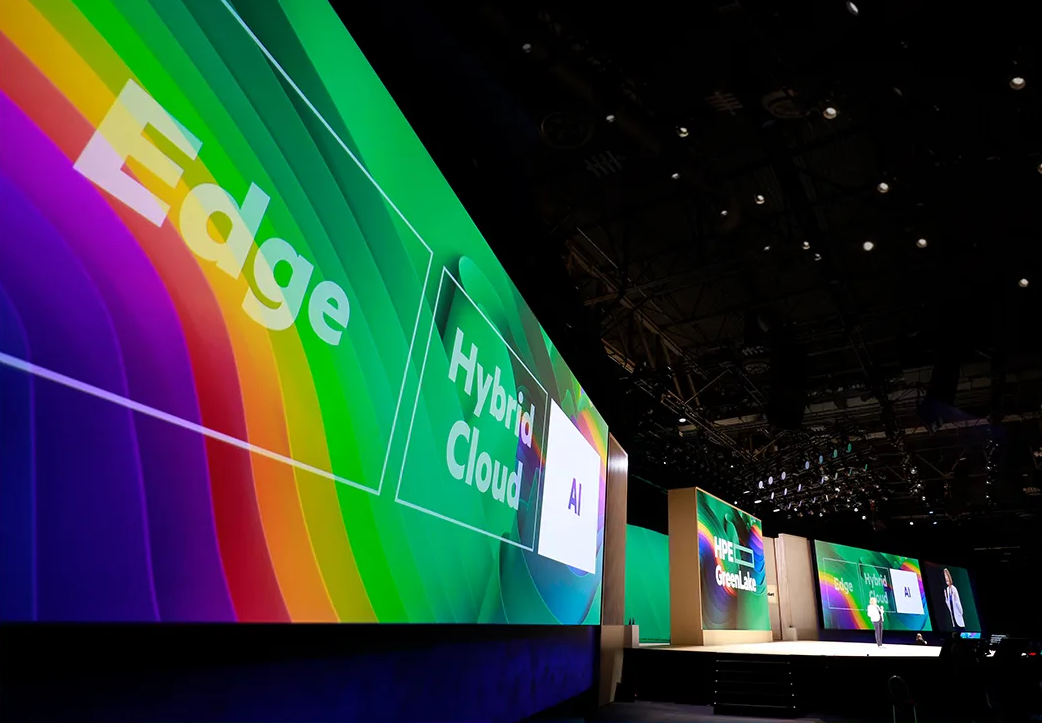News in Cloud Computing & Data Storage
Data
Data Centre Infrastructure News & Trends
Data Centre Operations: Optimising Infrastructure for Performance and Reliability
Data Centre Software for Smarter Operations
News in Cloud Computing & Data Storage
Hitachi Vantara launches Virtual Storage Platform 360
Hitachi Vantara, the data storage, infrastructure, and hybrid cloud management subsidiary of Hitachi, today announced the launch of Virtual Storage Platform 360 (VSP 360), a unified management software solution designed to help customers simplify data infrastructure management operations, improve decision-making, and the delivery of data services. With support for block, file, object, and software-defined storage, VSP 360 consolidates multiple management tools and aims to enable IT teams, including those with limited storage expertise, to more efficiently control hybrid cloud deployments, gain AIOps predictive insights, and simplify data lifecycle governance.
Organisations today are struggling to manage sprawling data environments spread across disparate storage systems, fragmented data silos, and complex application workloads, all while grappling with overextended IT teams and rising demands for compliance and AI readiness. A recent survey showed AI has led to a dramatic increase in the amount of data storage that businesses require, with the amount of data expected to increase 122% by 2026. The survey also revealed that many IT leaders are being forced to implement AI before their data infrastructure is ready to handle it, with many embarking on a journey of experimentation, hoping to find additional ways to recover some of the cost of their investments.
VSP 360 seeks to address these obstacles by integrating data management tools across enterprise storage to monitor key performance indicators, including storage capacity utilisation and overall system health, helping to deliver optimal performance and efficient resource management. It intends to improve end-to-end visibility, leveraging AIOps observability to break down data silos, as well as streamlining the deployment of VSP One data services.
“VSP 360 represents a bold step forward in unifying the way enterprises manage their data,” says Octavian Tanase, Chief Product Officer, Hitachi Vantara. “It’s not just a new management tool—it’s a strategic approach to modern data infrastructure that gives IT teams complete command over their data, wherever it resides. With built-in AI and automation and by making it available via SaaS, Private, or via your mobile phone, we're empowering our customers to make faster, smarter decisions and eliminate the traditional silos that slow innovation.”
“VSP 360 gives our customers the unified visibility and control they’ve been asking for,” claims Dan Pittet, Senior Solutions Architect, Stoneworks Technologies. “The ability to manage block, file, object, and software-defined storage from a single AI-driven platform helps streamline operations and reduce complexity across hybrid environments. It’s especially valuable for IT teams with limited resources who need to respond quickly to evolving data demands without compromising performance or governance.”
"VSP 360 hits the mark for what modern enterprises need," states Ashish Nadkarni, Group Vice President and General Manager, Worldwide Infrastructure Research, IDC. "It goes beyond monitoring to deliver true intelligence across the storage lifecycle. The solution's robust data resiliency helps businesses maintain continuous operations and protect their critical assets, even in the face of unexpected disruptions. By integrating advanced analytics, automation, and policy enforcement, Hitachi Vantara is giving customers the agility and resilience needed to thrive in a data-driven economy.”
For more from Hitachi, click here.
Joe Peck - 20 May 2025
Data Centre Operations: Optimising Infrastructure for Performance and Reliability
Enterprise Network Infrastructure: Design, Performance & Security
News
News in Cloud Computing & Data Storage
Nokia partners with atNorth to support cloud services in Finland
atNorth, a Nordic colocation, high-performance computing and AI service provider, has announced plans to support Nokia’s cloud infrastructure with a multi megawatt deployment at its FIN02 site in Finland (pictured above). The contract spans over 12 years and includes potential extensions totalling over 10MW.
Nokia, one of the world’s leading telecommunications and networking technology companies, is headquartered in Finland and has long utilised Finnish data centres, leveraging the country’s cool climate and renewable energy sources to ensure the sustainability of its workloads. In fact, the business was ranked as the most sustainable telecoms and communications company in the world earlier this year.
Nokia and atNorth have built a long-standing relationship through atNorth’s use of Nokia data centre switches that power its HPCaaS offering, which currently runs from its data centres in Iceland and Sweden.
Well versed in the evolving data centre landscape, Nokia was looking for a data centre partner that could accommodate its high-density infrastructure needs without compromising its environmental credentials. The business required capacity suitable for high-density workloads of more than 130kw per rack, available at speed and with the potential for future scalability.
Located in Espoo, Greater Helsinki, atNorth’s newest data centre, FIN02, runs on renewable energy and features robust power and liquid cooling capabilities. Built for scalability, its modular design supports high-performance workloads. A collaboration with Kesko Corporation enables waste heat recycling to heat a nearby store, further lowering its carbon footprint.
“atNorth was able to meet our complex technical requirements at speed without compromising on our sustainability goals,” says Marika Mentula, Vice President for Network Infrastructure North Europe at Nokia. “By helping support our cloud infrastructure at atNorth’s FIN02 data center, we can deliver high-performance infrastructure that supports our most demanding applications.”
Eyjólfur Magnús Kristinsson, CEO of atNorth, adds, “As the data centre industry continues to grow at record speed, it’s clear that businesses are increasingly seeking the full package - sustainable, secure, infrastructure that can scale rapidly. Our longstanding partnership with Nokia, rooted in the hardware demands of our HPCaaS offering and built on a shared commitment to sustainability, is a testament to that. It adds to a growing list of globally recognized companies that trust atNorth with their mission-critical data and rely on us to deliver best-in-class service.”
The news follows atNorth’s recent announcement of its heat reuse partnership with retail giant, Kesko Corporation at its FIN02 data centre in Finland. The business has two other metro sites near Helsinki, and a fourth ‘mega’ site - which is currently in development in Kouvola - is expected to be operational by the end of 2025.
For more from atNorth, click here.
Simon Rowley - 29 April 2025
Artificial Intelligence in Data Centre Operations
Data
Data Centre Operations: Optimising Infrastructure for Performance and Reliability
Enterprise Network Infrastructure: Design, Performance & Security
News in Cloud Computing & Data Storage
Juniper and Google Cloud enhance branch deployments
Juniper Networks has announced its collaboration with Google Cloud to accelerate new enterprise campus and branch deployments and optimise user experiences. With just a few clicks in the Google Cloud Marketplace, customers can subscribe to Google’s Cloud WAN solution alongside Juniper Mist wired, wireless, NAC, firewalls and secure SD-WAN solutions.
Unveiled at Google Cloud Next 25, the solution is designed to simply, securely and reliably connect users to critical applications and AI workloads whether on the internet, across clouds or within data centres.
“At Google Cloud, we’re committed to providing our customers with the most advanced and innovative networking solutions. Our expanded collaboration with Juniper Networks and the integration of its AI-native networking capabilities with Google’s Cloud WAN represent a significant step forward,” says Muninder Singh Sambi, VP/GM, Networking, Google Cloud. “By combining the power of Google Cloud’s global infrastructure with Juniper’s expertise in AI for networking, we’re empowering enterprises to build more agile, secure and automated networks that can meet the demands of today’s dynamic business environment.”
AIOps key to GenAI application growth
As the cloud expands and GenAI applications grow, reliable connectivity, enhanced application performance and low latency are paramount. Businesses are turning to cloud-based network services to meet these demands. However, many face challenges with operational complexity, high costs, security gaps and inconsistent application performance. Assuring the best user experience through AI-native operations (AIOps) is essential to overcoming these challenges and maximising efficiency.
Powered by Juniper’s Mist AI-Native Networking platform, Google’s Cloud WAN, a new solution from Google Cloud, delivers a fully managed, reliable and secure enterprise backbone for branch transformation. Mist is purpose-built to leverage AIOps for optimised campus and branch experiences, assuring that connections are reliable, measurable and secure for every device, user, application and asset.
“Mist has become synonymous with AI and cloud-native operations that optimise user experiences while minimising operator costs,” says Sujai Hajela, EVP, Campus and Branch, Juniper Networks. “Juniper’s AI-Native Networking Platform is a perfect complement to Google’s Cloud WAN solution, enabling enterprises to overcome campus and branch management complexity and optimise application performance through low latency connectivity, self-driving automation and proactive insights.”
Google’s Cloud WAN delivers high-performance connections for campus and branch
The campus and branch services on Google’s Cloud WAN driven by Mist provide a single, secure and high-performance connection point for all branch traffic. A variety of wired, wireless, NAC and WAN services can be hosted on Google Cloud Platform, enabling businesses to eliminate on-premises hardware, dramatically simplifying branch operations and reducing operational costs. By natively integrating Juniper and other strategic partners with Google Cloud, Google’s Cloud WAN solution enhances agility, enabling rapid deployment of new branches and services, while improving security through consistent policies and cloud-delivered threat protection.
Carly Weller - 11 April 2025
Artificial Intelligence in Data Centre Operations
Data Centre Operations: Optimising Infrastructure for Performance and Reliability
Data Centres
News in Cloud Computing & Data Storage
Raxio lands $100m to expand sub-Saharan African data centres
Raxio Group has signed an agreement for $100 million in financing from the International Finance Corporation (IFC) to accelerate Raxio’s expansion of data centres to power key technologies like AI, cloud computing and digital financial services – critical enablers of African economic growth and digital inclusion.
The debt funding from IFC will help Raxio double its deployment of high-quality colocation data centres within three years, addressing growing demand in underserved markets across the continent. The company is developing a Sub-Saharan African regional data centre platform in countries including Ethiopia, Mozambique, the Democratic Republic of Congo, Côte d’Ivoire, Tanzania and Angola.
Raxio is committed to bridging Africa’s digital divide by introducing Tier III-certified, carrier-neutral, and secure data services to markets that have been overlooked by other providers. With a focus on high-growth areas, the company is tapping into regions with significant economic potential to unlock new opportunities across the continent.
“Raxio’s business model shows how digital infrastructure can empower businesses, governments and communities to thrive in the digital economy,” says Sarvesh Suri, IFC Regional Industry Director, Infrastructure and Natural Resources in Africa. “This partnership between Raxio and IFC is set to strengthen Africa’s digital ecosystem and catalyse further investments and regional integration, building a more inclusive and sustainable future.”
“This funding from IFC is a powerful endorsement of Raxio’s vision and operational excellence,” says Robert Skjødt, CEO of Raxio Group. “It will allow us to bring critical infrastructure to the regions that need it most and attract further investment as we continue to grow. Together with our other partners, we’re building the foundation for Africa’s digital future and setting new benchmarks for sustainability.”
Raxio’s facilities are designed for 24/7 reliability, ensuring uninterrupted service even during maintenance or unforeseen disruptions. The company integrates renewable energy solutions to minimise its environmental footprint and uses innovative energy-efficient equipment to reduce electricity and water consumption for cooling in several of its countries of operation.
In the Democratic Republic of Congo, Raxio’s Kinshasa facility is poised to meet growing demand for data services in one of Africa’s largest and fastest-growing urban centres. In Côte d’Ivoire, Raxio is establishing a digital hub to serve Francophone West Africa, connecting regional markets and facilitating cross-border trade. These efforts are empowering local businesses and integrating them into the global digital economy.
Carly Weller - 7 April 2025
Data Centre Operations: Optimising Infrastructure for Performance and Reliability
News
News in Cloud Computing & Data Storage
Google Cloud appoints new regional Vice President
Google Cloud has announced the appointment of Maureen Costello as Vice President, United Kingdom and Ireland (UKI) and Sub-Saharan Africa. In this role, Maureen will oversee the company's sales strategy and operations across both regions.
Maureen brings nearly three decades of industry experience to Google Cloud, having previously served as Corporate Vice President for Industry Solutions Delivery at Microsoft. Prior to her role at Microsoft, she held several leadership positions during her 25-year tenure at Accenture, including Senior Managing Director and Resources Lead for UKI.
"It’s an honour to join Google Cloud at such a pivotal time in its journey," Maureen comments. "We have a tremendous opportunity to help businesses across the UKI and Sub-Saharan Africa harness the full potential of the cloud, from AI and data analytics to cyber security and sustainability. I am eager to build on the strong foundation already in place."
Maureen joins Google Cloud at a key stage in its growth trajectory. The company has recently announced major relationships in the UK with organisations including BT, John Lewis & Partners, Vodafone, and WPP. In Africa, Google Cloud opened its first region in Johannesburg, South Africa, in January 2024, and has committed $1 billion to support digital transformation initiatives across the continent.
"Maureen is a proven leader with an exceptional track record of driving growth and building high-performing teams," notes Tara Brady, President, EMEA, Google Cloud. "Her deep industry expertise and understanding of the unique needs of customers will be invaluable as we continue to expand Google Cloud's presence in these key markets. We are thrilled to welcome her to the Google Cloud EMEA leadership team."
Google Cloud is a new way to the cloud, providing AI, infrastructure, developer, data, security, and collaboration tools built for today and tomorrow. It offers a powerful, fully integrated and optimised AI stack with its own planet-scale infrastructure, custom-built chips, generative AI models and development platform, as well as AI-powered applications, to help organisations transform. Customers in more than 200 countries and territories use Google Cloud as their trusted technology partner.
For more from Google Cloud, click here.
Simon Rowley - 10 January 2025
Data Centre Operations: Optimising Infrastructure for Performance and Reliability
Data Centres
News
News in Cloud Computing & Data Storage
AWS Direct Connect Location available at Telehouse Osaka
KDDI Corporation, parent company to Telehouse, has announced today the availability of an Amazon Web Services (AWS) Direct Connect Location at its Telehouse Osaka data centre in Japan.
Telehouse Osaka customers can now directly access over 240 AWS cloud services, including AWS's generative AI via AWS Direct Connect, a cloud service that links customer networks directly to AWS Regions (data centres) through a dedicated network from Telehouse Osaka. This enables low-latency and secure connections to their own cloud environments.
Telehouse Osaka will reportedly be the first data centre in Japan operated by a Japanese telecommunications company to provide a dedicated connection point to AWS Direct Connect. Globally, this will be the third AWS Direct Connect site to implement the service, following Telehouse PARIS Voltaire and Telehouse London Docklands.
Takeyuki Yanagisawa, General Manager, Connectivity DC Planning Department at KDDI, comments, “The AWS Direct Connect Location at Telehouse Osaka allows for the creation of a secure and private link between AWS cloud services and our customers’ IT systems within the data centre. This setup significantly enhances throughput and ensures stability of our customers’ networks.”
“Additionally, by using the fibre core-based data centre interconnection service in the Osaka Business Park, customers can also access their IT infrastructure from other data centres.”
For more from KDDI, click here.
Simon Rowley - 9 January 2025
Data Centre Operations: Optimising Infrastructure for Performance and Reliability
News
News in Cloud Computing & Data Storage
Alibaba named 'leader' in Public Cloud Platforms report
Alibaba Cloud, the digital technology and intelligence backbone of Alibaba Group, has been named a 'Leader' in The Forrester Wave: Public Cloud Platforms Q4 2024 report.
Alibaba Cloud believes this designation recognises its depth of its cloud and AI offerings and strategy, its significant global presence, as well as the ability to provide its global customers with a wide range of products and services. This is the first time Alibaba Cloud has been recognised as a Leader among other significant public cloud platform providers in this report.
Alibaba Cloud is named one of four leaders among nine global vendors evaluated in Forrester’s report, with the second highest scores in the current offering and strategy categories. The report states that Alibaba Cloud showed its capacity for AI innovation with homegrown AI models, breadth of foundation model choices and model-as-a-service (MaaS) innovation. The report also states that the core infrastructure and model-as-a-service capabilities enable Alibaba Cloud to provide a major model repository for AI across China.
“Alibaba has upped the ante on serverless beyond AI, packaging its powerful cloud-native infrastructure into more accessible offerings for both developers and operators, with data and analytics as a stand out,” Forrester notes in the report. “Alibaba is a good fit for Chinese-based enterprises or international corporations requiring cloud scale across APAC and parts of Africa, Europe, and Latin America.”
The Forrester report is a 30-criterion evaluation of the nine most significant public cloud platform providers. Each provider is evaluated on the strengths of their current offerings, strategy and market presence. Alibaba Cloud has achieved the highest possible assessment score (5.0 out of 5.0) in 17 criteria, including database, data integration and governance services, container and Kubernetes services, serverless/FaaS services, compute, IoT, storage services, as well as AI development services.
Jingren Zhou, Chief Technology Officer of Alibaba Cloud Intelligence, comments, “Expanding our cloud-native infrastructure and AI capabilities in the public cloud space to better support our clients is a top priority. We are honoured to be recognised by Forrester for our efforts in this critical area. To address the increasing demands of AI, we are dedicated to continuously enhancing our ability to provide accessible, scalable, and reliable cloud products and AI applications to our customers.”
At Apsara Conference 2024, Alibaba Cloud’s annual flagship event hosted in September, Alibaba Cloud unveiled a revamped full-stack infrastructure designed to meet the growing demands for robust AI computing. It also released over 100 of its newly-launched large language models, Qwen 2.5, to the global open-source community. Qwen, Alibaba Cloud’s proprietary large language model, has seen significant adoption since its introduction in April 2023. The Qwen models have been downloaded over 40 million times on open-source platforms such as Hugging Face and ModelScope, and have inspired the creation of more than 78,000 derivative models.
As a creator of the MaaS concept and an advocate of open source, Alibaba Cloud also built ModelScope, China’s biggest AI model community. It hosts over 10,000 models and serves more than 8 million developers.
Alibaba Cloud continues to expand its global reach, currently operating 85 data centres in 28 regions globally. In May 2024, Alibaba Cloud announced plans to launch its first cloud region in Mexico, and to establish additional data centres in its key markets including Malaysia, the Philippines, Thailand, and South Korea in the next three years.
For more from Alibaba Cloud, click here.
Simon Rowley - 3 January 2025
Data Centre Build News & Insights
Data Centre Operations: Optimising Infrastructure for Performance and Reliability
Data Centre Projects: Infrastructure Builds, Innovations & Updates
News
News in Cloud Computing & Data Storage
Nationwide migrates IT estate to HPE GreenLake cloud
Hewlett Packard Enterprise today announced that Nationwide Building Society has selected HPE GreenLake cloud for its private cloud deployment, enabling it to accelerate its hybrid cloud journey. With the addition of HPE GreenLake Management Services as a strategic cloud services provider, Nationwide is now using the power of cloud technology to support the evolving needs of its customers.
In 2018, Nationwide kick-started an ambitious journey to ensure it was primed for the next generation of digital innovation, with its hybrid cloud strategy being driven by the need for different cloud environments for various types of data and workloads. Leveraging the comprehensive capabilities of HPE GreenLake, Nationwide is creating an agile, scalable, secure, resilient, and efficient technology platform.
“In today’s world our customers expect us to deliver an always-on service whilst providing new, innovative features that help them better manage their finances,” says Paul Walsh, Director of Infrastructure & Service Delivery, at Nationwide Building Society. “Nationwide’s hybrid cloud strategy is vital to our ability to compete and means we can continue to meet the needs and expectations of our customers. HPE GreenLake cloud is a core component of our hybrid cloud strategy. With them we’re building a cloud platform that will further improve our resilience and agility, enabling us to provide even better levels of service and deliver new capabilities to our developers faster than ever before.”
With HPE GreenLake Management Services, Nationwide’s IT team will automate and orchestrate infrastructure management and deliver infrastructure as code. This enables them to focus on innovation, value-add activities and gain better control over application builds and security. Faster release cycles will accelerate the time to market, providing consistent customer experiences across all digital platforms. At the same time, Nationwide can ensure that sufficient controls are in place to manage risk, protect their customers and meet the demands of regulators, while unlocking the value of cloud technology.
Nationwide’s hybrid cloud strategy fully embraces cloud economics, enabling efficient monitoring and management of consumption. HPE GreenLake's consumption-based model prevents overprovisioning and allows Nationwide to only pay for capacity that it is using. This is expected to support Nationwide in reducing its IT cost base by at least 30%.
Furthermore, a dedicated service within HPE GreenLake cloud gives the building society a clear overview of their energy consumption and emissions, enabling Nationwide to manage its infrastructure more efficiently and reduce the environmental impact. The impact will be further reduced by upcycling and recycling of decommissioned assets, such as the end-of-use compute and storage infrastructure that GreenLake has replaced.
“We are proud to support Nationwide with their cloud vision, providing them with enhanced control and security and the reliability and flexibility for growth,” says Matt Harris, Senior Vice President and Managing Director, UK, Ireland, Middle East and Africa at HPE. “Nationwide’s modernisation journey showcases the effectiveness of HPE GreenLake cloud, with the storied institution transitioning from complex, legacy technology to a modern, future-proofed hybrid cloud operating model, where a one-size-fits all public cloud could never be the only answer."
For more from HPE, click here.
Simon Rowley - 19 November 2024
Data Centre Operations: Optimising Infrastructure for Performance and Reliability
Enterprise Network Infrastructure: Design, Performance & Security
News
News in Cloud Computing & Data Storage
CtrlS Datacenters announces direct access to Oracle Cloud
CtrlS Datacenters, Asia’s largest Rated-4 data centre operator and a member of Oracle PartnerNetwork (OPN), today announced it will offer its customers direct high-speed connectivity to Oracle’s cloud and AI services through Oracle Cloud Infrastructure (OCI) FastConnect.
Organisations can harness the power of AI and a full suite of over 150 cloud services, including Oracle Autonomous Database, using the Oracle Cloud Mumbai Region and the Oracle Cloud Hyderabad Region to unlock innovation and drive business growth.
Through dedicated 2x100G Partner ports, CtrlS Datacenters offers customers both shared and dedicated access to OCI FastConnect. This enables organisations to:
• Reduce latency and improve performance: experience faster data transfer, minimising lags and disruptions for optimal application performance• Enhance security: dedicated network paths and robust encryption help ensure secure migration and management of workloads in OCI• Increase agility and scalability: scale cloud resources to support evolving business needs, fostering greater flexibility and adaptability
This collaboration with Oracle is designed to empower organisations in key markets, such as Hyderabad and Mumbai, to access OCI services with enhanced speed, security, and reliability. Customers across all CtrlS data centres will be able to get the OCI FastConnect nodes in Hyderabad and Mumbai.
With OCI, customers can benefit from best-in-class security, consistent high-performance, simple and predictable pricing, and the tools and expertise needed to bring enterprise workloads to cloud quickly and efficiently.
Beyond Mumbai and Hyderabad, enterprise customers of CtrlS Datacenters across all markets (Bangalore, Noida, Lucknow, and Patna) can benefit from OCI FastConnect through their Cloud Connect portfolio. Chennai and Kolkata will follow soon. This solution leverages diverse connectivity options to deliver secure and reliable access to OCI, regardless of physical location.
Sridhar Pinnapureddy, Founder & Chairman, CtrlS Datacenters & Cloud4C, comments, "Our unwavering commitment lies in being a market leader, not just in Rated-4 data centres, but also in building a comprehensive interconnection ecosystem that empowers businesses across India. Partnering with Oracle to provide direct access connectivity options to OCI marks a significant step towards this vision.
“It's not just about offering services; it's about equipping organisations with the agility and security they need to thrive in the cloud-driven era. This expansion reinforces our dedication to bridging the gap between ambition and achievement, propelling organisations toward a brighter future."
OCI’s extensive network of more than 100 FastConnect global and regional partners offers customers dedicated connectivity to Oracle Cloud regions, providing customers with optimal cloud deployment options anywhere in the world.
For more from CtrlS Datacenters, click here.
Simon Rowley - 12 November 2024
Data Centre Operations: Optimising Infrastructure for Performance and Reliability
News
News in Cloud Computing & Data Storage
Tata unveils AI infrastructure with NVIDIA accelerated computing
Tata Communications today announced a transformative upgrade to its AI cloud infrastructure in India, powered by NVIDIA Hopper GPUs.
The company says that the strategic collaboration marks a significant milestone in the country’s AI journey, and that it positions Tata Communications as a key player in enabling AI applications across a wide spectrum of industries - including manufacturing, healthcare, retail, and banking and financial services - and equipping them with the computing power needed to handle complex AI workloads.
As part of the initiative, Tata Communications will integrate cutting-edge NVIDIA software solutions such as NVIDIA NIM microservices, and the NVIDIA Omniverse and NVIDIA Isaac platforms, into its AI Cloud offerings. These technologies will provide businesses with an extensive suite of tools and services designed for AI-driven simulation, automation and more.
At the end of this year, Tata Communications will begin the first phase of its large-scale deployment of Hopper GPUs, establishing itself as one of the largest NVIDIA Hopper GPU cloud-based supercomputers in India. The second phase, planned for 2025, will further expand the infrastructure with Blackwell GPUs.
Tata Communications is poised to disrupt the AI landscape with an AI studio, a ground-breaking, all-in-one platform designed to transform how businesses use AI, by offering tools like AI Workbench, Model Garden, Responsible AI and serverless functions.
Furthermore, its advanced tools will simplify distributed data management, allowing businesses to efficiently collect and curate data across various enterprise systems and move it to the AI Cloud using Tata Communications' IZO Multi Cloud Connect platform. This approach will ensure cost-effectiveness and scalability for enterprises, while maintaining their existing data structures.
Complementing this is Tata Communications' CloudLyte Edge Computing platform, which enables low-latency inferencing, allowing businesses to deploy models at the edge for real-time responses. Together, these innovations empower enterprises to fully harness the power of AI.
“AI is expanding the boundaries of innovation and revolutionising business in ways we could never have imagined,” says AS Lakshminarayanan, MD & CEO, Tata Communications. “Therefore, every entity must prioritise AI integration to stay competitive. We are delighted to partner with NVIDIA to build a unique and transformative Cloud Fabric that will empower a generation of Indian innovators and entrepreneurs, fostering a vibrant AI ecosystem and propelling the nation towards a future fuelled by AI.”
Providing enterprises with a powerful infrastructure capable of handling complex AI workloads will help drive AI adoption across India. Combining NVIDIA’s AI platform with TATA Communications’ global network, will create a national supercomputing framework, driving innovation and helping elevate India’s role in the global AI player ranks.
“Tata Communications’ AI cloud infrastructure, integrating NVIDIA accelerated computing, will support businesses of all sizes - from AI startups to large enterprises - helping drive AI transformation across various sectors of the Indian economy and creating a powerful ecosystem for AI innovation,” adds Jay Puri, Executive Vice President of Worldwide Field Operations at NVIDIA.
Tata Communications customers will also gain access to the NVIDIA AI Enterprise software platform on its accelerated infrastructure, which is designed to let users build, customise and run generative and agentic AI applications in production. This includes NVIDIA NIM Agent Blueprints, which provide customisable reference architectures for use cases like digital human technologies or AI virtual assistants for customer service, multimodal PDF extraction workflows for enterprise data retrieval and container security workflows for cyber security.
Enterprises can also create their own AI models using the NVIDIA NeMo end-to-end platform for developing custom generative AI, and run efficient AI inference through NVIDIA’s NIM microservices - both part of the NVIDIA AI Enterprise - offering unparalleled flexibility and performance for AI workloads.
By integrating NVIDIA technologies, Tata Communications will continue to demonstrate its commitment to building next-generation AI infrastructure and services, positioning the company to lead India’s AI transformation and make AI more accessible across industries.
For more from Tata Communications, click here.
Simon Rowley - 24 October 2024

Head office & Accounts:
Suite 14, 6-8 Revenge Road, Lordswood
Kent ME5 8UD
T: +44 (0)1634 673163
F: +44 (0)1634 673173









